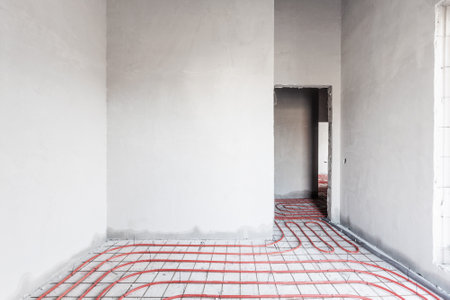Understanding Local Laws and Regulations
If you’re thinking about turning your finished basement into a rental unit, it’s important to first understand the legal requirements in your area. Every city and state in the U.S. has its own set of rules for basement rentals, so taking time to check these will save you headaches down the road.
Zoning Laws
Zoning regulations determine what kind of units can be rented out in your neighborhood. Some areas don’t allow basement apartments at all, while others have specific guidelines about how they must be constructed and used.
| Requirement | What to Check |
|---|---|
| Zoning District | Is your property zoned for multi-family or accessory dwelling units (ADUs)? |
| Unit Size & Use | Does your city allow separate rental units in single-family homes? |
| Occupancy Limits | Are there limits on the number of unrelated tenants? |
Permits and Inspections
You usually need permits before converting a basement into a rental. This could include building permits, electrical permits, and sometimes special rental licenses. Most cities will also require an inspection to make sure everything meets code before tenants move in.
Common Permits Needed:
- Building permit (for structural changes)
- Electrical/plumbing permits (if updating utilities)
- Rental license (required by some cities)
Egress Requirements
Egress means that people can safely exit the basement in an emergency. Most local building codes require that every bedroom has at least one window or door large enough for someone to escape through. Make sure windows meet minimum size standards and that there’s a clear path outside.
Typical Egress Window Requirements:
- Minimum opening width: 20 inches
- Minimum opening height: 24 inches
- Total opening area: At least 5.7 square feet
- No more than 44 inches from floor to window sill
Building Code Compliance
Your finished basement must comply with local building codes covering things like ceiling height, ventilation, fire safety, heating, and electrical systems. Codes help ensure the space is safe and comfortable for tenants.
| Aspect | Common Standard |
|---|---|
| Ceiling Height | At least 7 feet (some areas allow 68″) |
| Smoke/CO Detectors | Required in living areas and bedrooms |
| Heating/Ventilation | Adequate heat source; proper ventilation required |
| Electrical Outlets | Sufficient outlets per room; GFCI outlets near water sources |
The bottom line is: always start with research! Before making any plans or investments, reach out to your local building department or check city websites for details on what’s allowed where you live.
2. Designing a Comfortable and Legal Rental Space
Practical Tips for a Basement Rental Unit
Turning your finished basement into a rental unit can be a great way to generate extra income, but it’s important to make sure the space is not only inviting but also compliant with local building codes. Here are some practical tips and design ideas that will help you create a comfortable, legal, and attractive basement rental in the U.S.
Key Elements for an Appealing Basement Rental
| Element | Description | Tips & Ideas |
|---|---|---|
| Lighting | Basements often lack natural light, which can make them feel dark and uninviting. | – Install recessed LED ceiling lights – Add floor or table lamps for warmth – Use light-colored walls and floors to reflect light |
| Ventilation | Good airflow is crucial for comfort and health. | – Ensure windows can open – Consider installing an ERV or HRV system – Use exhaust fans in kitchen and bathroom areas |
| Soundproofing | Reduce noise between the main house and the rental unit for privacy. | – Add insulation to ceilings and shared walls – Use solid-core doors – Install carpets or area rugs to absorb sound |
| Private Entrance | A separate entrance increases tenant privacy and appeal. | – Create a dedicated exterior door if possible – Add clear signage or pathway lighting for safety – Make sure entrances meet local code requirements for egress |
| Code Compliance | Your unit must meet local building and safety codes. | – Check ceiling height requirements (usually at least 7 feet) – Ensure proper emergency exits (egress windows) – Install smoke and carbon monoxide detectors as required by law |
Additional Design Suggestions
- Kitchens: Even a small kitchenette with a microwave, mini fridge, and sink adds value.
- Bathrooms: A private bathroom is highly recommended; use space-saving fixtures if needed.
- Storage: Provide closet space or built-in shelves for convenience.
- Laundry: Shared or in-unit laundry facilities are attractive features for tenants.
- Flooring: Choose moisture-resistant options like vinyl planks or tile, which are ideal for basements.
- Neutral Colors: Stick with neutral palettes to appeal to more renters and make spaces feel larger.
Remember Local Regulations Matter!
Laws on basement rentals vary by city and state. Always check with your local housing authority or building department before making renovations to ensure your project is both safe and legal. Proper design not only attracts better tenants but also keeps you protected from potential legal issues down the road.
![]()
3. Estimating Costs and Project Budget
Budgeting for Basement Renovations
Turning your finished basement into a rental unit can be an exciting investment, but it’s important to have a clear budget before starting. Costs can vary widely based on the size of your basement, the current condition, and local requirements. Here’s a simple breakdown of common expenses to help you plan:
| Category | Typical Cost Range (USD) | Details |
|---|---|---|
| Renovation & Construction | $20,000 – $60,000+ | Includes framing, drywall, flooring, insulation, windows, and waterproofing. |
| Permits & Inspections | $1,000 – $5,000 | Depends on city/county codes and the extent of work required. |
| Kitchens/Bathrooms | $7,500 – $25,000+ | If adding or upgrading these spaces for tenant use. |
| Furnishings & Appliances | $2,500 – $8,000 | Beds, sofas, kitchen appliances, laundry machines, etc. |
| Ongoing Maintenance | $500 – $2,000/year | Repairs, cleaning services, utility checks. |
Understanding Permitting Costs and Requirements
In most U.S. cities and towns, you’ll need permits to legally rent out your basement. This may involve submitting plans to your local building department and passing inspections. Some areas require separate egress windows or upgraded fire safety measures. Check with your local government early in your planning process so you can factor these fees—and any upgrades—into your budget.
Tip:
If you’re hiring contractors, make sure they’re licensed and familiar with rental property codes in your area. This helps avoid costly redos down the road.
Furnishing Your Rental Basement Unit
If you want to attract quality tenants and possibly charge higher rent, consider providing basic furnishings and appliances. This can include beds, couches, tables, kitchen appliances (stove/oven, refrigerator), washer/dryer units, and window coverings. Shopping sales or buying gently used items can help keep these costs down without sacrificing comfort or style.
Suggested Basic Furnishings Checklist:
- Bedframe and mattress (twin or queen)
- Sofa or loveseat
- Coffee table/end tables
- Dresser or closet storage solutions
- Kitchenaid appliances (fridge/stove/microwave)
- Washer & dryer (if not shared with main house)
- Lamps/lighting fixtures
- Curtains or blinds for privacy
Planning for Ongoing Maintenance Expenses
A well-maintained rental keeps tenants happy and protects your investment. Set aside funds annually for routine maintenance such as HVAC servicing, plumbing checks, gutter cleaning (if applicable), pest control, and touch-up painting between tenants. This proactive approach prevents small issues from turning into big problems later on.
4. Marketing Your Basement Rental
Strategies for Advertising Your Rental Unit
Getting the word out about your finished basement rental is one of the most important steps to finding the right tenant. In the U.S., renters often start their search online, so posting your listing on popular websites like Zillow, Craigslist, Apartments.com, and Facebook Marketplace is a smart move. Take high-quality photos that show off the best features of your basement—good lighting, updated fixtures, or unique design elements can make your unit stand out. Don’t forget to mention amenities like in-unit laundry, parking, or private entrances. Posting flyers at nearby coffee shops or community centers can also attract local interest.
Popular Platforms for Rental Listings
| Platform | Best For | Cost |
|---|---|---|
| Zillow Rentals | Wide exposure, easy application process | Usually free for first listing |
| Craigslist | Local renters, budget-conscious tenants | Low fee per listing |
| Apartments.com | Diverse renter pool, detailed filters | Free basic listing |
| Facebook Marketplace | Quick responses, community reach | Free |
| Local bulletin boards/coffee shops | Neighborhood renters, word-of-mouth referrals | Free/low cost |
Screening Tenants Effectively
Once you start getting inquiries, screening potential tenants carefully is key to a good rental experience. Always use a rental application that asks about employment history, income, previous rental addresses, and references. In the U.S., it’s common to run background and credit checks (with the applicant’s permission). This helps you avoid future problems with late payments or property damage. Trust your instincts—if something feels off during communication or interviews, it’s okay to keep looking for another candidate.
Key Steps in Tenant Screening Process
| Step | Description |
|---|---|
| Rental Application | Collect personal info, employment details, and references. |
| Credit Check | Assess financial responsibility and payment history. |
| Background Check | Look for past criminal activity or eviction records. |
| Reference Calls | Talk to previous landlords or employers about reliability. |
| In-Person Interview/Viewing | Meet applicants to get a sense of personality and fit. |
Setting the Right Rent Price Based on Comparable Listings
Pricing your basement rental competitively ensures you attract good tenants while maximizing your income potential. Start by researching similar listings in your neighborhood—look at units with comparable square footage, amenities, and location. Websites like Zillow Rent Zestimate or Rentometer can give you a ballpark figure. Be realistic: if your basement has fewer windows or lower ceilings than above-ground apartments, you might need to set the rent slightly lower. On the flip side, if you offer perks like all utilities included or private laundry facilities, you could justify a higher price.
Factors to Consider When Setting Rent Price:
| Factor | Description |
|---|---|
| Location | Desirability of neighborhood & proximity to transit/schools |
| Amenities | Laundry, parking, separate entrance, utilities included |
| Size & Condition | Total square footage & quality of renovations/upgrades |
| Market Rates | The going rate for similar rentals nearby |
A Simple Example:
If similar basement rentals in your area are listed for $1,200–$1,400/month and yours has new appliances but no private parking, setting your rent around $1,250 could help fill it quickly without leaving money on the table.
Taking these steps will help you successfully market your finished basement as a desirable rental unit that attracts reliable tenants at the right price point.
5. Income Potential and Tax Implications
Estimating Your Rental Income
Turning your finished basement into a rental unit can be a great way to generate extra income. The amount you can earn depends on several factors like location, size, amenities, and the local rental market. Generally, basement rentals in suburban areas might fetch between $800 and $1,500 per month, while urban locations or those near universities could go higher.
| Location Type | Estimated Monthly Rent |
|---|---|
| Suburban | $800 – $1,200 |
| Urban/Metro | $1,200 – $2,000+ |
| Near College Campus | $1,000 – $1,800 |
Common Expenses for Basement Rentals
While rental income is appealing, it’s important to consider common expenses that come with being a landlord. These costs can include:
- Utilities: Heat, electricity, water, internet (sometimes included in rent)
- Maintenance & Repairs: Ongoing upkeep such as plumbing fixes or appliance replacement
- Insurance: Increased premium for landlord or rental property coverage
- Property Taxes: May increase if your home is reassessed due to the new unit
- Legal & Permit Fees: Costs associated with getting your basement certified as a legal rental unit
- Advertising & Leasing: Listing fees or agent commissions to find tenants
| Expense Type | Average Monthly Cost (Estimate) |
|---|---|
| Utilities (if included) | $100 – $200 |
| Maintenance & Repairs | $50 – $100 |
| Insurance Increase | $20 – $50 |
| Property Tax Increase* | $30 – $100* |
| Legal/Permit Fees (one-time) | $500 – $2,000* |
| Advertising/Leasing (as needed) | $50 – $200* |
*One-time or annual costs are broken down into monthly averages for budgeting purposes.
Important Tax Considerations for Homeowners
If you’re renting out part of your home, you’ll need to report that rental income on your federal tax return. However, you may also be able to deduct certain expenses related to the rental space. Here are some key points to keep in mind:
- Rental Income Reporting: All rent payments you receive must be reported as income.
- Deductions: You can typically deduct a percentage of mortgage interest, property taxes, insurance, utilities, repairs, and depreciation based on the portion of your home used as a rental.
- Depreciation: You may depreciate the part of your home used for the rental over 27.5 years.
- Record Keeping: Keep detailed records of all expenses and income related to the basement unit.
- State & Local Taxes: Some states or cities have additional tax rules for rental units—check with a local tax professional.
- Selling Your Home: Renting out part of your home could affect capital gains exemptions when you sell—consult with a CPA before making long-term decisions.
Sample Deductible Expenses Table (If 25% of Home Is Rented)
| Total Annual Expense Type | Total Amount Paid ($) | % Allocated to Rental Unit* | Your Deduction ($) |
|---|---|---|---|
| Mortgage Interest | $8,000 | 25% | $2,000 |
| Property Taxes | $6,000 | 25% | $1,500 |
| Homeowners Insurance | $1,200 | 25% | $300 |
| Total Utilities | $2,400 | 25% | $600 |
| Total Maintenance/Repairs | $1,200 | 25% | $300 |
| Total Deductible Amount for Rental Unit Yearly | $4,700 |
*Consult with a tax advisor for personalized guidance on deductions and reporting requirements.
The potential for extra income from renting your finished basement is real but comes with responsibilities. Make sure you budget accurately and know how taxes will impact your bottom line so you can maximize your earnings while staying compliant with local laws and IRS regulations.


